Pyrethroid resistance ‘main cause of Barley Yellow Dwarf Virus’

The high levels of barley yellow dwarf virus (BYDV) seen in cereal crops last year can in part be attributed to the widespread pyrethroid resistance in the grain aphid (Sitobion avenae), an expert warned.
Speaking at the AICC annual technical conference, Alan Dewar of Dewar Crop Protection pointed out that although the mild conditions of last winter certainly aided aphid survival, movement, virus transmission and the ineffectiveness of insecticides should take most of the blame.
“The BYDV epidemic last year has wrongly been blamed on the bird cherry-oat aphid (Rhopalosiphum padi) because the grain aphid predominates in crops during the summer, when it feeds on ears,” said Mr Dewar.
“However, I witnessed a crop that had received two foliar pyrethroid applications and still had many yellow patches across the field.
“Some of the aphids found in those patches were Sitobion avenae and when tested it was found they contained the knock-down resistance (Kdr) gene to pyrethroids, so it begs the question, how much were they to blame?”
Furthermore, widespread sampling carried out in 2012 by Mr Dewar and Rothamsted Research found that almost all the grain aphid populations, from Norfolk to Hampshire, contained the Kdr gene to varying proportions.
Active Ingredients
Aphox – pirimicarb
Decis Protech – deltamethrin
Dursban – chloropyrifos
Hallmark – lambda-cyhalothrin
Toppel – cypermethrin
“Looking over the data from the past three years we have seen a dramatic rise in that proportion, which is down to the over-use of cheap pyrethroids,” Mr Dewar said.
Product efficacy
In addition to the results from population testing, Mr Dewar set up trials in autumn 2012 to find out the efficacy of some common insecticides when attempting to control grain aphids early in the season.
At two sites in Suffolk and Cambridgeshire, winter barley was inoculated with BYDV carrying grain aphids around markers. “We then treat the crop with insecticide and measure any further spread of BYDV symptoms after treatment,” explained Mr Dewar.
The insecticides applied were Aphox, Hallmark, Toppel and Dursban, however, neither Aphox nor Dursban are approved for autumn aphid control.
“Pyrethroid product Toppel gave significantly poorer control than the other applications, with Aphox not performing well either. Hallmark performed better than expected, but it was used at a higher rate of 75ml/ha, with only 50ml/ha permissible in winter cereals,” Mr Dewar told delegates.
“Dursban gave very good control, but of course it can’t be used specifically for aphids,” he added.
Using different aphid populations and comparing Hallmark, Toppel and Decis Protech Mr Dewar also detected differences between the pyrethroid products when controlling aphids carrying the Kdr resistance gene. The higher rate of Hallmark and Decis Protech were more effective than Toppel, but he admitted that more work needed to be carried out in this area.
“If you are faced with these aphids next summer it would be advisable to remember that there are differences between these products and it may be better to avoid them altogether and use an alternative mode of action,” advised Mr Dewar.
“However, if Sitobion avenae becomes a serious problem in the autumn again, like I think it did last year, we may have a problem with control due to lack of approved and effective products,” he warned.
See how weather affected crops in 2012

